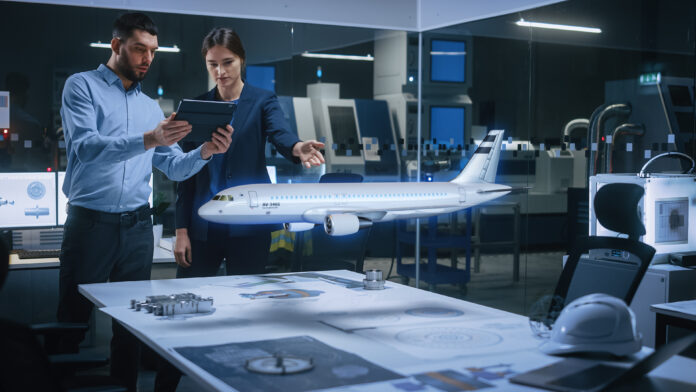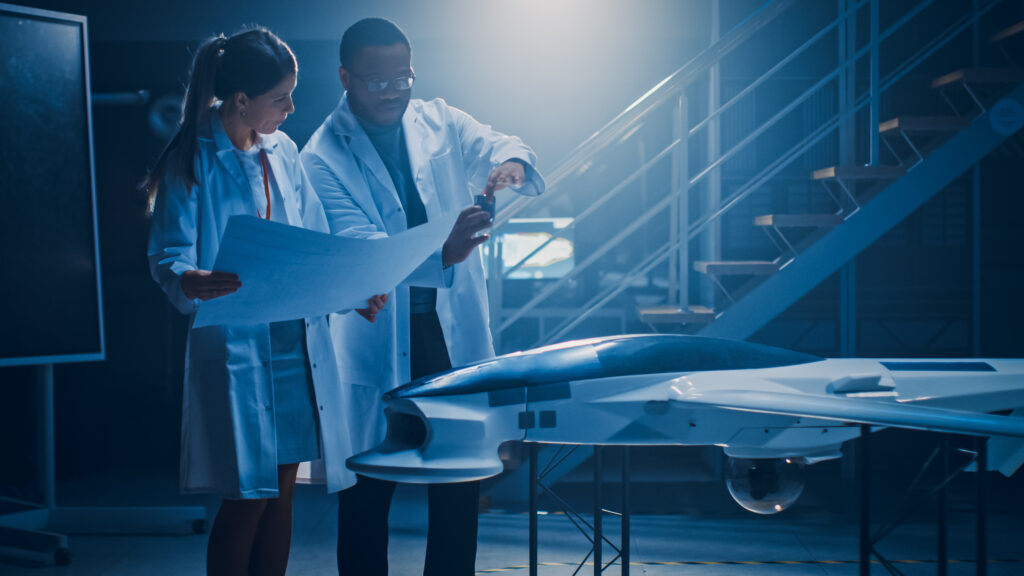In 2023, the aerospace and defense (A&D) industry witnessed a revival in product demand, with domestic commercial aviation revenue passenger kilometers surpassing prepandemic levels in most countries. This surge in air travel led to an increased demand for new aircraft and aftermarket products and services.
Globally, industries are steering towards sustainable and efficient practices, and the realm of aircraft production seamlessly aligns with this transition. By using advanced methods and technologies, the aerospace industry is leading the way in addressing new challenges and meeting the complex needs of global transportation and space exploration.
Within this dynamic context, many emerging trends are poised to fundamentally transform aerospace manufacturing, heralding a future brimming with innovation and advancement. Technological advances in the aerospace industry are improving sustainability, digitizing legacy systems, and automating processes.
Continue reading to unveil the future trends shaping aerospace manufacturing and how they advance your business.
Automation And Robotics
The aerospace industry has traditionally been known for its high-precision, meticulous processes. However, integrating automation and robotics transforms production lines, taking efficiency and accuracy to new heights.
To explore the impact of these technologies, consider the following points:
* Unmatched precision: Manufacturing components for aircraft requires incredible accuracy, as even the slightest deviations can compromise safety and performance. Robots excel in this area, consistently performing tasks with the precision that surpasses human capabilities. This minimizes errors and ensures the consistent quality of every part.
* Boosted efficiency: Automation streamlines the production process by automating repetitive tasks previously done by human workers. This frees up human expertise for more complex tasks while robots tirelessly handle drilling, fastening, painting, and other assembly line operations. The result is a significant increase in production speed, allowing for faster aircraft assembly and reduced lead times.
* Enhanced safety: Aerospace manufacturing often involves working with large, heavy components or hazardous materials. Robots can take on these dangerous tasks, reducing the risk of workplace injuries for human workers. This creates a safer work environment and allows human employees to focus on tasks that require dexterity, judgment, and critical thinking.
By embracing automation and robotics, aerospace manufacturers are poised to achieve significant advancements in productivity and safety. These integrated technologies will set new standards for excellence in the industry, ensuring the efficient and precise production of next-generation aircraft.
Sustainable Manufacturing Practices
Aerospace manufacturers prioritize eco-friendly practices throughout production in today’s environmentally conscious world.
Here are some ways the industry is achieving greater sustainability:
* Eco-friendly materials: Traditionally, aerospace relied on heavy metals. Now, the shift is towards lighter composite materials. These not only reduce the environmental impact of aircraft manufacturing but also contribute to improved fuel efficiency during operation, lowering overall emissions.
* Renewable energy sources: Manufacturing facilities are increasingly powered by renewable energy sources like solar and wind. This significantly reduces reliance on fossil fuels and lowers carbon emissions associated with production.
* Advanced waste reduction: Minimizing waste is a crucial aspect of sustainable manufacturing. Aerospace companies are adopting advanced recycling techniques and implementing stricter waste management protocols. This conserves resources and minimizes the industry’s environmental footprint.
Adopting sustainable practices demonstrates aerospace manufacturers’ commitment to environmental responsibility. This positions them as leaders in the fight against climate change and resonates with a growing base of eco-conscious consumers.
Additive Manufacturing
Additive manufacturing, also known as 3D printing, rapidly transforms the aerospace industry. This technology offers unique advantages that revolutionize how aircraft components are designed and produced. Here’s a closer look at how 3D printing is taking flight:
* Unparalleled design freedom: Unlike traditional manufacturing methods, 3D printing allows for the creation of complex, intricate structures. This opens doors for innovative designs that were previously impossible, such as lightweight components with internal lattices for superior strength.
* Reduced waste and cost: Traditional manufacturing often involves significant material waste. 3D printing builds components layer by layer, minimizing material consumption. This not only reduces costs but also aligns with sustainability goals. Additionally, 3D printing is ideal for producing small batches of specialized parts, making it cost-effective for low-volume applications.
* Rapid prototyping and iteration: The ability to quickly print prototypes is a major advantage of 3D printing. Aerospace companies can rapidly design, print, and test parts, accelerating development and allowing for faster iteration and design improvements. This significantly reduces the time and cost of bringing new aircraft designs to market.
Leveraging the power of 3D printing, aerospace manufacturers are achieving new heights in design innovation, production efficiency, and environmental responsibility. This technology will undoubtedly play a vital role in the future of aerospace manufacturing.
Conclusion
As the aerospace manufacturing industry stands on the brink of a transformative era, it’s evident that the sector is advancing towards a future characterized by innovation, efficiency, and sustainability. The integration of automation and robotics, the adoption of sustainable manufacturing practices, and the pioneering use of additive manufacturing are setting new benchmarks for technological advancement and environmental stewardship. These pivotal trends enhance aircraft production and performance and herald a new age in aerospace engineering that places equal emphasis on progress and planetary well-being.























